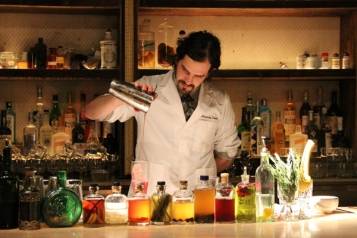
Nowadays, it’s pretty commonplace for chefs to know where their ingredients come from. But to know the name of the fishermen—even those nearly 1,000 miles away in Nova Scotia—well, that takes farm… er… sea-to-table to a whole new level. “Every single morning I get phone calls from nine or 10 different fishmongers,” reveals Executive Chef Ted Pryor of The Sea Fire Grill in Manhattan. “I have two Hawaiian guys who tell me when they land certain fish, and they’ll cut it up, pack it, and it’ll be here the next day.”
Though the classically-trained chef has access to some of the world’s most succulent seafood—from Maine lobsters to Canadian halibut—his favorite proteins come from right here in New York. “I love all the east coast stuff, especially the real local stuff like the swordfish we get from Montauk and Points North. And all the east coast oysters! We feature up to eight or 10 oysters on the menu at a time.” It’s this kind of unbridled excitement and meticulous attention to detail that separates Pryor from the sea of other fine dining chefs—and the reason, that on a freezing January night, The Sea Fire Grill is packed to capacity.
When did you realize that you wanted to become a chef?
My family lived in Paris before I was born, and they brought back this love of fine cooking and fine food. My father had this really marvelous garden when I was growing up so we always had fresh produce in the house that my mom cooked, so it was always part of my family life. After college, I went down to the local French bistro and knocked on the back door (they happened to have two really, really good chefs who trained in France, like me) and they said, “Yeah, sure, come on in.”
How does The Sea Fire Grill differ from other fine dining establishments in NYC?
We’ve gone back to the roots of New York cuisine, where we focus on very fresh ingredients and we take great care in how we source those ingredients. We present them simply with just two or three components on the plate so the main ingredient—the fish—really shines.

What is your favorite dish currently on the menu?
Right now, I really love the snapper presentation, but American red snapper is becoming a little scarce because it’s been stormy in the Gulf, so the fishermen are having trouble finding it.
How often does the menu change?
It’s always gradual. As the seasons change, we alter things. For example, as asparagus goes out of season, tomatoes move in. We are one of those restaurants that really caters to regulars so we like having some dishes that we keep on the menu at all times, like halibut and swordfish.

Does sustainability factor into what you serve?
It’s definitely something we think about. We are mindful of which fisheries are more sustainable than others. Right now, the black bass is a local fish—there was a moratorium on fishing it about 10 years ago, but it’s coming back very strong. We use that as a special a fair amount because we know that it’s doing well.
You mentioned that the restaurant regularly offers several types of oysters. What’s the main difference between east coast and west coast oysters?
East coast oysters are saltier. They tend to be a little larger, but you can find them in all sizes. They taste more of the sea—like when you get rolled by a wave. They’ve got that real ocean flavor. West coast oysters are a little deeper; they’re milkier and sweeter. You can really tell by looking at them—they are way more beautiful and usually have purple edges.

What is your strategy for cooking for diners with dietary restrictions?
Just try to keep it simple. Chefs often make it too complicated. I simply want a happy customer to walk out the door. If you worry about your ego, what you can or can’t do, you’ll make yourself crazy. I tell myself that, make sure that my whole staff understands [the restriction] from top to bottom, and go out of my way. And I enjoy going out of my way because I’m doing the right thing and achieving my goal, which is a customer who is happy and will hopefully come back.
How large is your staff?
We have about 10 to 13 cooks. They all work between 50 and 60 hours per week, and are all very dedicated. We couldn’t do it without them.
Does the restaurant have a designated pastry chef?
No, but I think we do a very good job. The desserts are not super fancy. They don’t go up to the ceiling in their presentation, but we think they’re very solid. I think we have the best cheesecake in New York and I think our upside-down apple pie is fabulous. It’s kind of a variation of a French recipe. The first thing I ever learned in a restaurant was how to make an upside-down French apple pie.
You’ve cooked at so many high-profile restaurants including Orsay, Les Halles, and Michael Jordan’s The Steakhouse N.Y.C. Do you prefer working at a steakhouse or seafood establishment?
I think that the variation of seafood is much more interesting. Our steak is phenomenal, but it is what it is. Seafood is constantly changing, and obviously, the ocean can provide such diversity. Diversity keeps everything interesting.
What would you choose as your last meal on earth?
A cheeseburger made by my dad with smoked bacon, summer corn, and a great tomato salad. I’d want foie gras and caviar as a first course—and a soufflé for dessert.





















